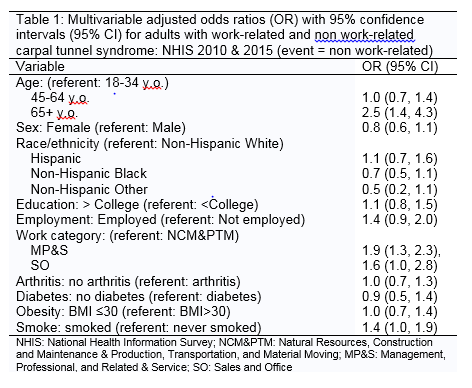Session Information
Session Type: ARHP Concurrent Abstract Session
Session Time: 11:00AM-12:30PM
Background/Purpose: The underlying causes of carpal tunnel syndrome (CTS) are complex and may be unrelated to work status. Yet, too often, CTS is viewed and researched only as a work-related disorder. There is almost no research that compares the characteristics of work-related versus non work-related disorders. In this study we used data from the 2010 and 2015 National Health Information Survey (NHIS), representative of the U.S. civilian non-institutionalized population, to determine which characteristics are risk factors for non work-related CTS compared to work-related CTS.
Methods: We analyzed adults (age 18+). CTS cases were defined as “Have you EVER been told by a doctor or other health professional that you have a condition affecting the wrist and hand called carpal tunnel syndrome?” and we designated whether CTS was work/non work-related by the response in those with CTS to the question “Have you ever been told by a doctor or other health professional that your CTS was probably work-related.” Arthritis and diabetes were self-reported in a similar fashion. Obesity was those with Body Mass Index (BMI) ≥30, and smoking as those who never or ever smoked. To identify occupational type, respondents were categorized in three major Standard Occupational Classification System categories (SOC): 1) Management, Professional, and Related & Service (MP&S); 2) Sales and Office (SO); 3) Natural Resources, Construction and Maintenance & Production, Transportation, and Material Moving (NCM&PTM), each of which represent progressively greater exposure to high-repetition, forceful tasks which are considered an important risk factor for work-related CTS.
We completed simple descriptive characteristics as well as a logistical regression using appropriate NHIS weights.
Results: Of our sample of 60,759 adults, 8.6% (95%CI: 8.4, 7.8) had CTS. Of these 65.5% (62.4, 68.6) were work-related and 34.5% (31.4, 37.6) were non work-related.
Characteristics associated with non work-related CTS were age greater than 65 (Odds Ratio [OR] 2.5: 95%CI 1.4, 4.3), working in jobs which do not typically have exposure to high–repetition, forceful tasks (MP&S OR 1.9: 1.3, 2.3; SO OR 1.6: 1.0, 2.8) and ever having smoked (OR 1.4: 1.0, 1.9) (See Table 1).
Conclusion: While work-related CTS is more common than non work-related CTS, at least a third of CTS cases are non work-related. Characteristic of those with non work-related CTS are similar to those with work-related CTS. The exceptions are age over 65, when people typically are not working, and those who do not generally have high repetition forceful jobs. Although co-morbidities, such as arthritis and obesity did not increase the risk of reporting non work-related CTS, ever having smoked was an independent risk factor. This study supports the need to examine all causes of CTS and consider it as a potential upper extremity issue, regardless of work-status.
To cite this abstract in AMA style:
Baker NA. Characteristics of People with Work-Related Versus Non-Work Related Carpal Tunnel Syndrome: National Health Interview Survey, 2010 & 2015 [abstract]. Arthritis Rheumatol. 2017; 69 (suppl 10). https://acrabstracts.org/abstract/characteristics-of-people-with-work-related-versus-non-work-related-carpal-tunnel-syndrome-national-health-interview-survey-2010-2015/. Accessed .« Back to 2017 ACR/ARHP Annual Meeting
ACR Meeting Abstracts - https://acrabstracts.org/abstract/characteristics-of-people-with-work-related-versus-non-work-related-carpal-tunnel-syndrome-national-health-interview-survey-2010-2015/

